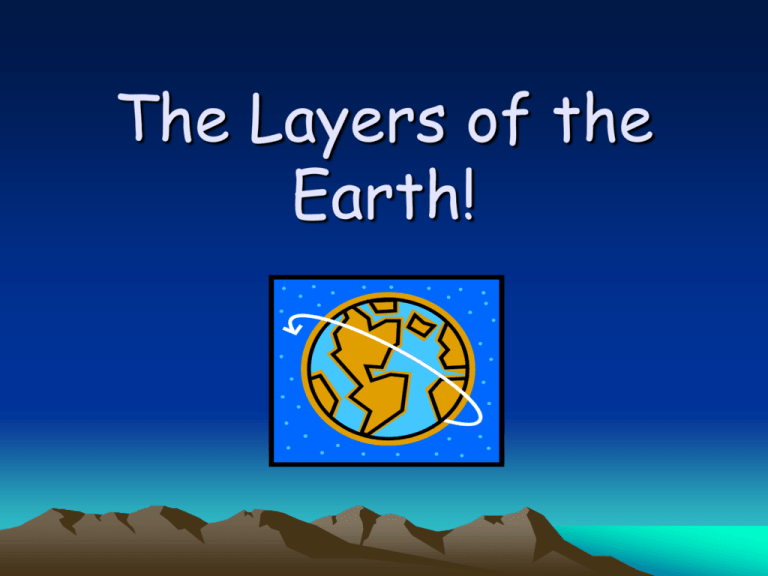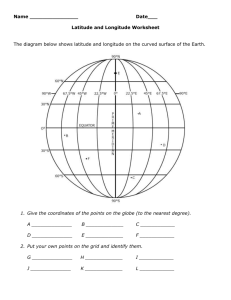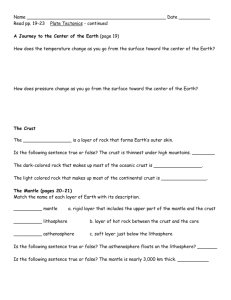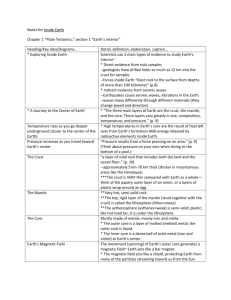The Layer's Of The Earth!
advertisement

The Layers of the Earth! Geologists study the process that create Earth features and search for clues about Earth’s history. Studying Surface Changes Finding Indirect Evidence • Forces above and below the surface of the Earth are constantly changing Earth’s appearance. • Geologists cannot observe Earth’s interior directly. Instead, they must rely on indirect methods of observation. Scientists record seismic waves and how they travel through the Earth in order to make some inferences about the Earth’s interior. • • Constructive forces shape the surface by building up mountains and landmasses. Example: the formation of the island of Surtsey through volcanic eruptions. Destructive forces slowly wear away mountains and eventually every other feature on the surface. • Example: Ocean waves that wear away a coastline. Journey to the Center of the Earth Temperature • About 20 meters down, the temperature of the surrounding rock begins to get warmer. For every 40 meters, that you descend from that point, the temperature rises 1◦C. This rapid rise in temperature continues for several kilometers. After that, the temperature increases more slowly, but steadily. Pressure • The deeper you go, the greater the pressure. Pressure is the force pushing on a surface or area. Because of the weight of the rock above, pressure inside the Earth increases as you go deeper. Earth Layers • The Earth is divided into four main layers. *Inner Core *Outer Core *Mantle *Crust The Crust (between 5 – 40 km thick) • The Earth’s crust is like the skin of an apple. It is very thin compared to the other three layers. • The crust is thinnest beneath the ocean floor and thickest under high mountains. Oceanic crust consists of a rock , basalt. Continental crust , forming the continents, is mostly of a less dense rock , granite. *The crust makes up 1% of the Earth. Sometimes scientists say that the crust has another layer called the lithosphere which rests on the very bottom of the crust and another one that rests on the top portion of the mantle called the asthenosphere. *The crust of the Earth is broken into many pieces called plates. Two sub-layers Lithosphere In Greek, “lithos” means stone This is a rigid layer located at the very bottom of the crust (where the plates are found). It is about 100 kms. Thick. Asthenosphere • In Greek, “asthenes” means weak • The asthenosphere (located at the very top of the mantle) is not weak but soft. The material in this layer can flow slowly, allowing the plates to move on top of it. The Mantle • The mantle is the layer below the crust. • The mantle (molten rock) is the largest layer of the Earth, about 3000 kms thick. • The mantle is divided into two regions: the upper and lower sections. Outer Core (2250 Km thick) * The core of the Earth is like a ball of very hot metals. * The outer core is molten liquid (iron and nickel). * The outer core is made up of iron and nickel and is very dense. Inner Core (1200 kms thick) * The inner core of the Earth has temperatures and pressures so great that the metals are squeezed together and are not able to move. * The inner core is a solid. Earth’s Magnetic Field (Magnetosphere) Currents in the liquid outer core force the solid inner core to spin at a slightly faster rate than the rest of the planet. These currents create the Earth’s magnetic field, which causes the planet to act like a giant bar magnet. Like a magnet, the Earth’s magnetic field has a North and a South pole. Review 1) What are the four layers of the Earth? 2) The Earth’s crust is very ______? 3) The mantle is the largest layer of the Earth? True or False 4) Is the Outer Core a liquid or a solid? Answers! 1) Crust, Mantle, Outer Core, Inner Core 2) Thin 3) True 4) Liquid







